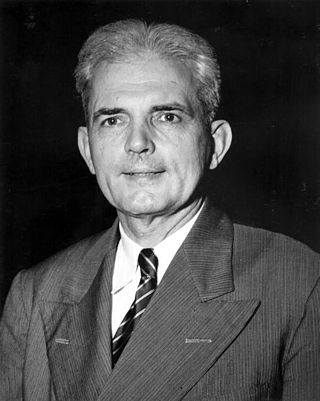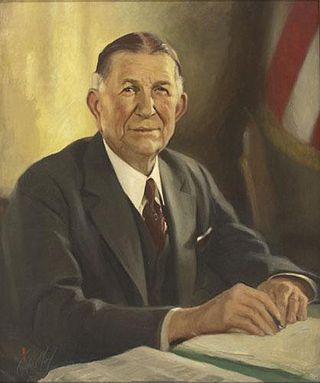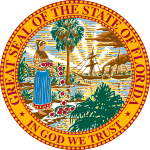
Spessard Lindsey Holland was an American lawyer and politician. He served as the 28th governor of Florida from 1941 to 1945, and later as a U.S. senator for Florida from 1946 to 1971. He was the first person born in Florida to serve as governor and U.S. senator for the state. While serving as a U.S. senator he would notably introduce the 24th Amendment.
Southern Democrats are members of the U.S. Democratic Party who reside in the Southern United States.

Millard Fillmore Caldwell was an American politician, lawyer, and jurist. He was the 29th governor of Florida (1945–1949) and served in all three branches of government at various times in his life, including as a U.S. representative and Florida Supreme Court justice.

The 1986 United States Senate elections were elections for the United States Senate. Held on November 4, in the middle of Ronald Reagan's second presidential term, the 34 seats of Class 3 were contested in regular elections. The Republicans had to defend an unusually large number of freshman Senate incumbents who had been elected on President Ronald Reagan's coattails in 1980. Democrats won a net of eight seats, defeating seven freshman incumbents, picking up two Republican-held open seats, and regaining control of the Senate for the first time since January 1981. This remains the most recent midterm election cycle in which the sitting president's party suffered net losses while still flipping a Senate seat.

Doyle Elam Carlton, Sr. was an American lawyer and politician who served as the 25th Governor of the state of Florida from 1929 to 1933.

Frederick Preston Cone was an American politician who served as the 27th Governor of Florida.

The 1970 United States Senate elections was an election for the United States Senate. It took place on November 3, with the 33 seats of Class 1 contested in regular elections. Special elections were also held to fill vacancies. These races occurred in the middle of Richard Nixon's first term as president. The Democrats lost a net of three seats, while the Republicans and the Conservative Party of New York picked up one net seat each, and former Democrat Harry F. Byrd Jr. was re-elected as an independent.

The 1964 United States Senate elections were held on November 3. The 33 seats of Class 1 were contested in regular elections. Special elections were also held to fill vacancies. They coincided with the election of President Lyndon B. Johnson by an overwhelming majority, to a full term. His Democratic Party picked up a net two seats from the Republicans. As of 2023, this was the last time either party has had a two-thirds majority in the Senate, which allowed the Senate Democrats to override a veto, propose constitutional amendments, or convict and expel certain officials without any votes from Senate Republicans. However, internal divisions would have prevented the Democrats from having done so. The Senate election cycle coincided with Democratic gains in the House in the same year.

The 1958 United States Senate elections were elections for the United States Senate which occurred in the middle of President Dwight D. Eisenhower's second term. Thirty-two seats of Class 1 were contested in regular elections, the new state of Alaska held its first Senate elections for its Class 2 and 3 seats, and two special elections were held to fill vacancies.

The 1950 United States Senate elections occurred in the middle of Harry S. Truman's second term as president. The 32 seats of Class 3 were contested in regular elections, and four special elections were held to fill vacancies. As with most 20th-century second-term midterms, the party not holding the presidency made significant gains. The Republican opposition made a net gain of five seats, taking advantage of the Democratic administration's declining popularity during the Cold War and the aftermath of the Recession of 1949. The Democrats held a narrow 49-to-47-seat majority after the election. This was the first time since 1932 that the Senate majority leader lost his seat, and the only instance of the majority leader losing his seat while his party retained the majority.

The 1936 United States Senate elections coincided with the reelection of President Franklin D. Roosevelt. The 32 seats of Class 2 were contested in regular elections, and special elections were held to fill vacancies. The Great Depression continued and voters backed progressive candidates favoring Roosevelt's New Deal in races across the country. The Democrats gained 5 net seats during the election, and in combination with Democratic and Farmer–Labor interim appointments and the defection of George W. Norris from the Republican Party to become independent, the Republicans were reduced to 16 seats. Democrats gained a further two seats due to mid-term vacancies. The Democrats' 77 seats and their 62-seat majority remain their largest in history.

Edward John Gurney Jr. was an attorney and an American politician based in Florida, where he served as a Representative and a United States Senator. Born and raised in Portland, Maine, Gurney moved to Florida after his service in World War II. Elected to the House of Representatives in 1962, Gurney was the second Republican elected to Congress from Florida in the 20th century.

Charles Oscar Andrews was a Democratic Party politician who represented Florida in the United States Senate from 1936 until 1946.
Ernest R. "Cap" Graham was an American politician active in Florida, having served as a member of the Florida Senate from 1937 to 1944, when he unsuccessfully ran for the Democratic nomination for Governor of Florida. As a state senator, he would help to successfully repeal Florida's poll tax in 1937.

The 1970 United States Senate election in Florida was held on November 3, 1970. Incumbent Democratic U.S. Senator Spessard Holland decided to retire instead of seeking a fifth term. During the Democratic primary, former Governor C. Farris Bryant and State Senator Lawton Chiles advanced to a run-off, having received more votes than Speaker of the Florida House of Representatives Frederick H. Schultz, attorney Alcee Hastings, and State Representative Joel T. Daves III. Chiles soundly defeated Bryant in the run-off election, scoring a major upset due to his comparatively small name recognition prior to the election. To acquire name recognition and media coverage, Chiles walked about 1,003 miles (1,614 km) across the state of Florida and was given the nickname "Walkin' Lawton".

The 1958 United States Senate election in Florida was held on November 4, 1958.

The 1964 United States Senate election in Florida was held on November 3, 1964. Incumbent Democratic U.S. Senator Spessard Holland was re-elected to a fourth term in office, defeating J. Brailey Oldham in the primary and Republican Claude R. Kirk Jr. in the general election.

The 1978 United States Senate special election in Alabama was held on November 7, 1978. It was a special election to fill the seat which had been held by Senator Jim Allen, who died on June 1. His widow Maryon was appointed on June 8 by governor George Wallace to fill the vacancy until a special election could be held.

The 1932 Florida gubernatorial election was held on November 8, 1932. Democratic nominee David Sholtz defeated Republican nominee William J. Howey with 66.62% of the vote.

The 1936 United States Senate special election in Florida was held on November 3, 1936. Charles O. Andrews was easily elected to fill the seat.





















